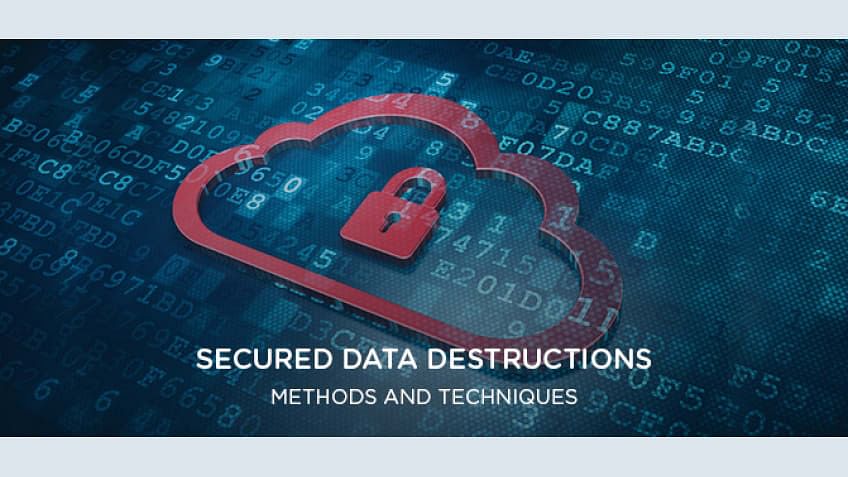Crucial Cyber Security Practices for Effective Data Destruction Approaches
Crucial Cyber Security Practices for Effective Data Destruction Approaches
Blog Article
The Value of Effective Data Damage Practices in Safeguarding Sensitive Info and Ensuring Computer System Safety
In a period where data breaches are significantly typical, the significance of effective information damage methods can not be overemphasized. Executing durable information damage techniques not just alleviates these dangers but also aligns with lawful compliance needs, ensuring that organizations promote their online reputation and foster client trust fund.
Understanding Data Devastation
Recognizing information destruction is essential in today's digital landscape, where sensitive information can quickly be endangered. Efficient data damage involves not just removing data however making certain that information is irretrievable with extensive techniques. This procedure is essential for organizations that handle confidential client details, intellectual home, or internal papers, as any breach can cause serious financial and reputational effects.
Information destruction encompasses numerous techniques, consisting of shredding physical media, degaussing magnetic storage devices, and using software-based services that overwrite data several times. Each technique offers a certain purpose and has to line up with the sensitivity of the information being disposed of. Physical devastation is typically favored for difficult drives containing extremely personal information, while software application approaches could be adequate for less delicate information.
In addition, sticking to sector criteria and guidelines, such as the General Information Security Policy (GDPR) or the Medical Insurance Mobility and Liability Act (HIPAA), is crucial for compliance and to alleviate legal dangers. Organizations must establish a durable data devastation plan, train employees on best methods, and consistently audit their treatments to make certain that all delicate information is taken care of safely and efficiently.
Threats of Inadequate Practices
Poor information destruction techniques reveal companies to significant threats that can have far-ranging effects. When delicate information is not correctly taken care of, it stays at risk to unapproved gain access to, which can lead to data breaches and identity theft. Such cases not only jeopardize the safety of individuals however additionally taint the organization's online reputation, causing a loss of client trust and prospective economic effects.
Furthermore, governing compliance is progressively strict in several markets. Failing to comply with data destruction guidelines can result in significant fines and legal activities against companies. These charges can draw away and strain financial sources focus from core company operations.
Furthermore, the misuse of residual information can cause copyright burglary or company espionage, endangering competitive benefits (data destruction). The effect of insufficient data destruction expands past instant economic losses; it can additionally result in lasting damages to brand name integrity and market setting

Organizations must acknowledge that data safety and security is not entirely about preventing breaches; it additionally incorporates the liable management of data throughout its lifecycle. Ignoring efficient information devastation procedures can have catastrophic ramifications, underscoring the necessity for robust measures to mitigate these threats.
Finest Practices for Information Damage
Applying reliable information destruction techniques is crucial for protecting sensitive information and maintaining conformity with regulative criteria. Organizations ought to take on a multi-faceted method to guarantee that data is irretrievable, thus preventing unauthorized gain access to and potential violations.
First, information ought to be categorized based on sensitivity, enabling companies to use appropriate destruction techniques tailored to the degree of danger. For digital data, utilizing software-based data-wiping devices that abide by industry criteria can successfully overwrite existing information. Physical destruction methods, such as shredding or degaussing, are crucial for gadgets that save delicate information, making sure full removal.
Establishing a clear information retention plan is essential, outlining the length of time different kinds of information ought to be kept before devastation. Routine audits of information storage systems are also essential to identify unnecessary or obsolete information requiring removal.
Furthermore, training staff members on the relevance of data damage and the specific protocols to follow fosters a society of security within the organization. Maintaining paperwork of information devastation processes provides accountability and sustains compliance with a fantastic read outside guidelines and internal plans. By sticking to these best practices, companies can substantially alleviate the risks related to information direct exposure.
Legal and Compliance Considerations

Failure to abide by these policies can result in severe charges, consisting of considerable fines and reputational damages. Organizations has to implement a robust information destruction policy that straightens with these lawful frameworks and supplies clear guidelines on the correct approaches of data disposal, whether physical shredding or electronic cleaning.
Additionally, preserving paperwork of data damage tasks is important for showing conformity during audits or evaluations. By focusing on lawful and compliance considerations, organizations can enhance their information security pose and foster trust fund with stakeholders and clients, inevitably adding to a more secure data management atmosphere.
Benefits of Effective Information Destruction
Efficient data damage methods extend past simple conformity; they offer significant benefits to organizations that prioritize them. By making sure that sensitive info is irretrievably destroyed, companies reduce the risk of data violations and the potential monetary effects linked with them. This positive strategy not only safeguards against unapproved gain access to but additionally enhances the general here are the findings trustworthiness of the company in the eyes of clients and stakeholders.
Carrying out robust information devastation approaches, such as physical destruction of storage gadgets or innovative information cleaning techniques, adds to the conditioning of an organization's cybersecurity stance. data destruction. It lowers the probability of copyright theft and safeguards exclusive information, thus keeping an one-upmanship in the market

Verdict
In conclusion, effective data devastation practices are essential for securing sensitive details and boosting overall computer protection. Eventually, a dedication to robust data destruction methods promotes a society of obligation, thereby reinforcing an organization's cybersecurity stance and keeping client count on.

Report this page